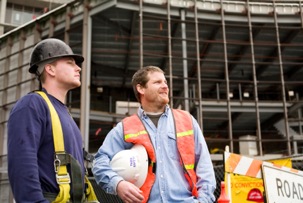Lung Cancer Answers is a website devoted to life issues for lung cancer patients and their families and is sponsored by Brad Cooper* of Cooper, Hart, Leggiero & Whitehead, PLLC. Cooper, Hart, Leggiero & Whitehead is located in The Woodlands, Texas (Greater Houston Area), handles cases nationwide with co-counsel in state of filing, and can be reached toll-free at 1-800-998-9729 for more information on lung cancer. Brad Cooper is not a medical doctor. The information on these pages is for the education of lung cancer patients and their families regarding potential medical and legal options. Patients are advised to consult with a medical doctor.
* Licensed by the Supreme Courts of Texas.
Workplace Exposure to Asbestos

Asbestos was a common material used in many products for decades. Many tradespeople were exposed to asbestos and especially those who worked with such products. For example, just cutting or shaping a linoleum tile, roofing shingle, piece of insulation or replacing brake pads on a car could have exposed you to asbestos.
It was not just people on the job working with the materials that had exposure. Teachers, custodial workers, hospital workers and many other professions have had exposure from materials used in commercial and public buildings.
Please review the list below of industries and occupations and determine if your work or home life related to these. Cases have been found where a wife or child of a tradesman developed cancer from the asbestos, most likely from the dust on the work clothes brought home.
If any of these situations apply to you, please call us at 1-800-998-9729 or contact us for more information and potential compensation.
Industries
Sites where asbestos exposure was typically the heaviest include:
- Chemical Plants
- Construction (residential, commercial, and industrial)
- Industrial Plants
- Power Plants
- Pulp and Paper
- Railroads
- Refineries
- Shipbuilding
- Textile Industry
- Manufacturing Plants
But note, just because you didn't work in one of these industries doesn't mean you weren't exposed on the job.
Occupations
Trades mostly commonly working with or around asbestos include:
- Aerospace Workers
- Aircraft Mechanics
- Asbestos Workers
- Automobile Mechanics
- Boilermakers
- Brickmasons
- Carpenters
- Cement/Masonry Workers
- Civil Engineers
- Demolition Workers
- Drywall Installers
- Electrical Engineers
- Electricians
- Elevator Installers
- Firefighters
- Foundry Workers
- Heating and Air Conditioning Workers
- Heavy Equipment Mechanics
- Industrial Engineers
- Industrial Plant Workers
- Ironworkers
- Laborers
- Longshoremen
- Machinists
- Mechanical Engineers
- Millwrights
- Oil Refinery Workers
- Operating Engineers
- Painters
- Pipefitters
- Plasterers
- Plumbers
- Power Plant Workers
- Railroad Workers
- Roofers
- Sheet Metal Workers
- Shipyard Workers
- Stationary Engineers
- Steamfitters
- Steel Workers
- Teachers
- Textile Workers
- Tile Setters
- Utility Workers
- Welders
Buildings Where Other Professionals Could Have Been Exposed
- Court Houses and Other Government Buildings
- Hospitals
- Post Offices
- Schools
Asbestos In Schools
Most buildings built or renovated before 2000, including schools, are likely to contain asbestos because it was widely used in building materials due to its fire-resistant and heat insulation properties. While schools are not required to abate asbestos from their buildings due to the high cost for it, many schools and local education agencies have some form of regulation in place to manage asbestos.
Undisturbed and undamaged, asbestos-containing materials are not a hazard risk. However, if they are disturbed, become damaged, or deteriorate over time, the deadly asbestos fibers can become airborne and would be considered highly dangerous.
A national regulation has been put in place to help manage asbestos in schools, known as the Asbestos Hazard Emergency Response Act. AHERA requires all public school districts and non-profit private schools to regularly have their schools inspected for the conditions of asbestos-containing materials and for air quality levels to see if asbestos is present.
Learn more about lung cancer exposures
If you have lung cancer and believe you have been exposed to asbestos, click here to learn more about compensation or call 1-800-998-9729 for a FREE consultation.

©2025 Cooper, Hart, Leggiero & Whitehead, PLLC. All rights reserved.